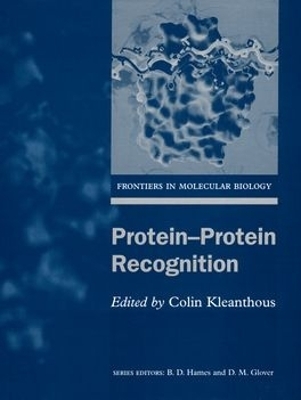
Protein-protein Recognition
Seiten
2000
Oxford University Press (Verlag)
978-0-19-963760-7 (ISBN)
Oxford University Press (Verlag)
978-0-19-963760-7 (ISBN)
Protein-protein recognition is a critical event controlling in a large number of cell processes and therefore is of interest to a large section of the biological community. The purpose of this book is to bring together important concepts and systems in a single volume.
The purpose of Protein-Protein Recognition is to bring together concepts and systems pertaining to protein-protein interactions in a single unifying volume. In the light of the information from the genome sequencing projects and the increase in structural information it is an opportune time to try to make generalizations about how and why proteins form complexes with each other. The emphasis of the book is on heteromeric complexes (complexes in which each of the components can exist in an unbound state) and will use well-studied model systems to explain the processes of forming complexes. After an introductory section on the kinetics, thermodynamics, analysis, and classification of protein-protein interactions, weak, intermediate, and high affinity complexes are dealt with in turn. Weak affinity complexes are represented by electron transfer proteins and integrin complexes. Anti-lysozyme antibodies, the MHC proteins and their interactions with T-cell receptors, and the protein interactions of eukaryotic signal transduction are the systems used to explain complexes with intermediate affinities. Finally, tight binding complexes are represented by the interaction of protein inhibitors with serine proteases and by nuclease inhibitor complexes. Throughout the chapters common themes are the technologies which have had the greatest impact, how specificity is determined, how complexes are stabilized, and medical and industrial applications.
The purpose of Protein-Protein Recognition is to bring together concepts and systems pertaining to protein-protein interactions in a single unifying volume. In the light of the information from the genome sequencing projects and the increase in structural information it is an opportune time to try to make generalizations about how and why proteins form complexes with each other. The emphasis of the book is on heteromeric complexes (complexes in which each of the components can exist in an unbound state) and will use well-studied model systems to explain the processes of forming complexes. After an introductory section on the kinetics, thermodynamics, analysis, and classification of protein-protein interactions, weak, intermediate, and high affinity complexes are dealt with in turn. Weak affinity complexes are represented by electron transfer proteins and integrin complexes. Anti-lysozyme antibodies, the MHC proteins and their interactions with T-cell receptors, and the protein interactions of eukaryotic signal transduction are the systems used to explain complexes with intermediate affinities. Finally, tight binding complexes are represented by the interaction of protein inhibitors with serine proteases and by nuclease inhibitor complexes. Throughout the chapters common themes are the technologies which have had the greatest impact, how specificity is determined, how complexes are stabilized, and medical and industrial applications.
Kinetics and thermodynamics of protein-protein interactions ; Analysis and classification of protein-protein interactions from a structural perspective ; Protein-protein complexes formed by electron transfer proteins ; Molecular basis of integrin-dependent cell adhesion ; Structure and energetics of anti-lysozyme antibodies ; Proteins of the major histocompatibility complex and their interactions with T-cell receptors ; Protein-protein interactions in eukaryotic signal transduction ; Interaction of standard mechanism, canonical protein inhibitors with serine proteinases ; Nuclease inhibitors
| Erscheint lt. Verlag | 1.1.2001 |
|---|---|
| Reihe/Serie | Frontiers in Molecular Biology ; 31 |
| Zusatzinfo | 8 pp colour plates, numerous line figures |
| Verlagsort | Oxford |
| Sprache | englisch |
| Maße | 189 x 246 mm |
| Gewicht | 755 g |
| Themenwelt | Naturwissenschaften ► Biologie ► Biochemie |
| Naturwissenschaften ► Biologie ► Genetik / Molekularbiologie | |
| Naturwissenschaften ► Biologie ► Zellbiologie | |
| ISBN-10 | 0-19-963760-1 / 0199637601 |
| ISBN-13 | 978-0-19-963760-7 / 9780199637607 |
| Zustand | Neuware |
| Haben Sie eine Frage zum Produkt? |
Mehr entdecken
aus dem Bereich
aus dem Bereich


